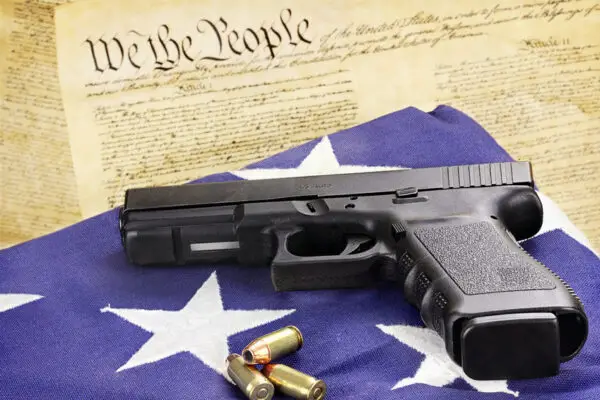
«A well-regulated militia being necessary to the security of a free State, the right of the people to keep and bear arms shall not be infringed».
«Essendo necessaria alla sicurezza di uno Stato libero una milizia regolamentata, il diritto dei cittadini di detenere e portare armi non potrà essere infranto». È questo il famoso secondo emendamento della Costituzione americana che sancisce il diritto dei cittadini a possedere armi, principio che ha fatto molto discutere nelle ultime settimane in seguito alla strage della scuola di Newtown in Connecticut, dove lo scorso 14 dicembre 2012 hanno perso la vita 20 bambini e 6 adulti. Un tema sempre attualissimo negli Stati Uniti, che solleva l’interesse dell’opinione pubblica mondiale. Tante le domande, una sola la risposta: lo strapotere delle lobby delle armi, prima fra tutte la NRA (National Rifle Association), che spingono per limitare la regolamentazione relativa agli armamenti leggeri. Le tesi sono essenzialmente due: c’è chi sostiene che per ridurre la criminalità e soprattutto le stragi sia fondamentale adottare norme più restrittive per limitare il numero di armi presenti nel Paese. E poi ci sono quelli che sostengono che uno Stato con più armi, detenute legalmente, è uno Stato più sicuro. La partita è aspra e a spuntarla finora sono state le lobby che sostengono una diffusione massiccia degli armamenti leggeri.
Come dicevamo, tutto ruota intorno al secondo emendamento sancito nel 1791, che affonda le sue radici storiche nelle occupazioni da parte dell’Impero britannico e spagnolo. Allora il possesso di un’arma da parte delle milizie cittadine era l’unico strumento che gli americani avevano per difendere territori, case e famiglie. Il forte senso della proprietà privata, da tutelare con ogni mezzo e senza intermediari, ha condizionato la cultura delle armi da fuoco e le legislazioni, più o meno restrittive, che si sono susseguite nel corso dei secoli, come spiega Jill Lepore in un articolo apparso sul New Yorker il 23 aprile 2012. Il reporter analizza i dati statistici relativi ai possessori di armi e traccia una storia della legislazione americana in merito, spiegando come la cultura delle armi da fuoco sia estremamente diffusa in ogni fascia della popolazione. Chiunque può possedere un’arma e imparare a sparare, proprio in virtù di quel secondo emendamento che nel 2008 ha ricevuto un’interpretazione ufficiale da parte della Corte Suprema degli Stati Uniti, la quale ha riconosciuto il diritto di portare armi come un diritto inviolabile al pari di quello al voto e della libertà di espressione.
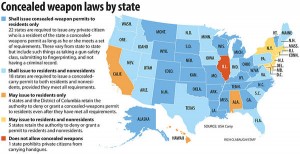
Ogni Stato ha le proprie regole, più o meno restrittive, ma in linea di massima le armi da fuoco devono essere ben visibili e senza il colpo in canna. Tuttavia, ci sono alcuni Stati che danno ai cittadini la possibilità di portare armi nascoste, previa autorizzazione da parte delle istituzioni. Un grafico pubblicato sulla rivista Cristian Science Monitor a marzo 2012 mostra la legislazione che regolamenta il permesso ai cittadini di portare armi da fuoco nascoste. Si va dagli Stati più permissivi, quelli di colore azzurro e celeste, in cui basta ottenere un’autorizzazione per girare con le armi nascoste, all’Illinois dove questa pratica è proibita.
Importante rilevare anche un altro dato: immediatamente dopo la strage di Newtown è stata corsa ai giubbotti anti-proiettile, agli zainetti speciali e alle piastre leggere studiati per i bambini. Una realtà raccontata sul sito Mother Jones, che evidenzia come la paura abbia portato i cittadini a volersi proteggere. E proprio sul senso di insicurezza di molti americani fanno leva le lobby, che spingono per un’ancora maggiore diffusione delle armi.
Ciò che appare chiaro, è che il problema delle armi è molto diffuso e deriva da ragioni culturali e sociali prima che economiche. Se da una parte, infatti, le lobby delle armi strumentalizzano il secondo emendamento per assicurarsi un mercato più ampio, dall’altra è evidente che in un Paese con un così radicato senso della proprietà privata qual è l’America, difficilmente i cittadini rinuncerebbero al diritto di difendere la propria persona e le proprie cose da chi li minaccia. Anche se il prezzo da pagare è la vita di uomini, donne e bambini che muoiono sotto i colpi di pazzi assassini che compiono stragi nelle scuole, nei cinema, per strada.
FRANCESCO VIGNARCA: «IL POTERE È IN MANO ALLE LOBBY
MA IL FATTORE CULTURALE È DETERMINANTE»

La stretta correlazione tra la diffusione delle armi e l’economia è sempre stata oggetto dell’interesse dell’opinione pubblica, che si è posta molte domande in merito alla diffusione degli armamenti leggeri e alla loro pericolosità. Un libro italiano, Armi, un affare di Stato (Chiarelettere), cerca di dare una risposta a tutte queste domande concentrandosi principalmente sui maggiori Paesi produttori ed esportatori di armi, tra cui c’è l’Italia. Francesco Vignarca, coautore del volume, ci spiega cosa muove il grande business delle armi, quale ruolo giocano le lobby americane e a cosa è dovuta la massiccia diffusione di armamenti leggeri negli Stati Uniti.
C’è una correlazione tra il business delle armi per l’esportazione e la vendita interna?
Non c’è una reale distinzione tra le due cose. Ci sono solo grossi produttori di armi che si rivolgono a grossi mercati, indipendentemente dalla loro collocazione, ad esempio per lo sport, la caccia o la difesa personale, mercato diffuso soprattutto negli Stati Uniti. Nei Paesi in cui ci sono conflitti, l’uso delle armi è diverso ma cambia poco per i produttori. La vera distinzione riguarda la regolamentazione. Nei mercati prevalentemente civili, gli armieri vogliono il minor numero di leggi possibile, per esercitare un controllo maggiore. Al contrario, quando la domanda arriva da fonti militari ed è legata al momento contingente, i produttori chiedono più controlli e le armi vengono fornite solo previ accordi governativi. Il vero business, visto che le armi hanno già un’ampia diffusione, sono i munizionamenti, che negli Stati Uniti è un mercato sicuro gestito da lobby come l’NRA.
Negli Usa si fa appello al secondo emendamento e al diritto di ogni cittadino di difendersi. Ma quale ruolo hanno le lobby delle armi nello strumentalizzare questo principio al fine di vendere i loro prodotti?
Un ruolo enorme. Hanno un grandissimo potere e riescono a controllare i principi che regolano il porto d’armi. In Italia, ad esempio, le armi vengono usate prevalentemente a scopo sportivo e di caccia, meno per la difesa personale, e le norme sul porto d’armi sono molto più restrittive. Inoltre, le lobby come l’NRA intervengono direttamente nei luoghi in cui avvengono stragi e fomentano la paura per vendere più armi. Inoltre, tentano di scardinare i blocchi legislativi. In occasione della strage di Newtown hanno dichiarato che il vero pericolo non era rappresentato dal ragazzo armato che ha ucciso oltre 20 persone, ma dal fatto che il personale scolastico, dagli insegnanti ai bidelli, non avesse armi per difendersi, senza considerare che chiunque potrebbe avere un momento di follia e commettere una strage. Quando si tratta di armamenti leggeri, quindi, l’NRA si mobilita subito verso i cittadini. Quando, invece, sono in gioco gli armamenti pesanti, come elicotteri e carrarmati, le lobby si rivolgono direttamente ai decisori politici per convincerli, spesso anche con dati fasulli, che armarsi è la scelta giusta.
La diffusione delle armi negli Usa quanto è dovuta a ragioni economiche e quanto a ragioni sociali e culturali?
Entrambe le cose hanno un peso considerevole. Il fattore economico conta perché nei Paesi ricchi, dove c’è maggiore benessere, le persone tendono ad armarsi di più per difendere se stessi e il loro stile di vita. Nelle zone economicamente poco sviluppate, invece, le armi sono ad uso quasi esclusivo della criminalità. Basti pensare che la Finlandia è il secondo Paese al mondo, dopo gli Stati Uniti, per diffusione di armi e uccisioni di massa. Il fattore culturale è imprescindibile perché le leggi di un Paese rispecchiano la sua storia sociale e culturale. Nazioni che hanno una storia simile agli Usa non hanno sviluppato la stessa cultura degli armamenti leggeri, sempre più diffusi nel Paese. Per questo credo che sia molto difficile che gli Stati Uniti cambino la propria legislazione introducendo norme più severe in merito alle armi.
OMICIDI IN AMERICA: TREND IN CALO, IL PICCO NEGLI ANNI ’90
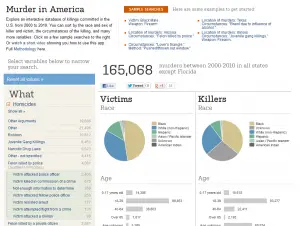
Sono 165,068 gli omicidi avvenuti negli Stati Uniti (esclusa la Florida) dal 2000 al 2010. Il dato è riportato dal Wall Street Journal che, attraverso una mappa interattiva, fornisce un quadro completo della situazione statunitense relative a quegli anni. Un menù posto sulla sinistra guida nella ricerca il lettore, che può ordinare i dati secondo diverse variabili, come la razza, l’età e il sesso degli assassini e delle vittime, le circostanze degli omicidi, le armi utilizzate. I risultati sono visibili sulla destra dove una serie di grafici mostrano tutti i dati raccolti, mentre in alto è possibile trovare una selezione dei risultati più significativi relativamente alle variabili precedentemente elencate. La mappa del giornale americano si basa sui dati diffusi dall’FBI.
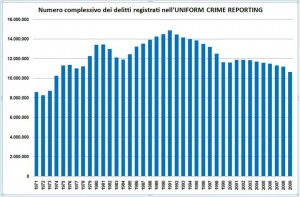
Come spiega l’OSSIF, il Centro italiano di Ricerca dell’ABI sulla Sicurezza Anticrimine, L’Uniform Crime Reporting Program (UCR) è gestito direttamente dall’FBI e riguarda i delitti registrati ufficialmente dalle Forze dell’Ordine. Produce ogni anno “Crime in the United States (CIUS)”, Rapporto basato su 81 Tavole statistiche concernenti i seguenti argomenti: delitti denunciati, delitti risolti, “cleared”, persone arrestate, organico e tipologia delle forze di polizia. Mentre la mappa interattiva del Wall Street Journal si concentra negli anni che vanno dal 2000 al 2010, il grafico proposto dall’Ossif si spinge molto più indietro fino ad arrivare al 1971.
Dai dati emerge che il numero dei delitti è cresciuto esponenzialmente fino al 1991, quando si è iniziata a registrare una lunga, seppur lenta, decrescita dei crimini violenti. Il tasso di omicidi continua a scendere ma resta sempre elevatissimo. Altro fattore da considerare nel valutare queste cifre è la crescita della popolazione degli USA, che è passata da 208 milioni nel 1971 a 307 milioni nel 2009 (+48 per cento).
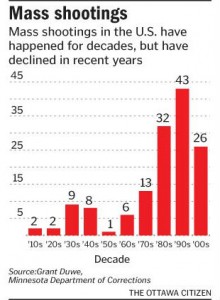
Interessanti anche i dati riportati dal giornale canadese Edmonton Journal che, sulla base di dati forniti da uno studioso statunitense, mostra l’andamento degli omicidi di massa con armi da fuoco negli Stati Uniti, divisi per decenni. Anche qui è possibile notare un picco in corrispondenza degli anni ’90 con 43 omicidi di massa, contro i 32 degli anni ’80 e i 26 degli anni 2000.
Le ragioni storiche dell’incremento dei crimini avvenuto a ridosso degli anni ’90 è da rintracciare nell’escalation della liberalizzazione delle armi da fuoco, iniziata nel 1987 quando la Florida rilasciò i primi permessi per il possesso di armi senza licenza di registrazione. Federico Giamperoli su Cronache Italiane fornisce un quadro molto dettagliato delle ragioni storiche e sociali che hanno portato all’aumento e successivamente alla diminuzione del tasso di omicidi negli Stati Uniti, sottolineando come il via libera della Florida abbia generato un effetto domino su tutti gli altri Stati. Il successo delle lobby degli armamenti tuttavia sarebbe da rintracciare in un più ampio contesto socio-criminale degli Usa, che vent’anni fa avevano un tasso di crimini violenti pari al quadruplo del resto d’Occidente. Di fronte al degrado urbano e ai fenomeni di de-industrializzazione delle metropoli iniziati negli anni ’70, la reazione armata dei cittadini fu immediata e generò un’ondata conservatrice che negli anni ’80 favorì la liberalizzazione delle armi e il conseguente diritto dei cittadini di difendere da soli la propria casa e proprietà privata, senza il rischio di incorrere in azioni penali per eccesso di reazione. Quando, nel 1994, Bill Clinton salì alla Casa Bianca cercò di frenare la spinta alla deregulation limitando la vendita dei fucili d’assalto e mitragliatori.
Quella attuale è un’America spaccata a metà sul difficile problema delle armi. Secondo un sondaggio Usa Today/Gallup il 58 per cento degli americani vorrebbe leggi più severe sulla armi, contro il 43 per cento dell’ottobre 2011. Ma solo il 44 per cento è a favore al bando dei fucili d’assalto mentre il 51 per cento è contrario. Quasi gli stessi numeri rispetto alla precedente rilevazione dell’ottobre 2011, 43 per cento a favore e 51 per cento contro. La via giusta non è ancora stata trovata. Obama ha promesso leggi più severe sul possesso e trasporto delle armi, ma deve fare i conti con le potentissime lobby. Riuscirà a limitarne lo strapotere?
Piera Vincenti
English Version
Article of Piera Vincenti – Translation of Tony Stanco
WEAPONS IN USA: A RIGHT OR JUST A BUSINESS?
«A well-regulated militia being necessary to the security of a free State, the right of the people to keep and bear arms shall not be infringed»
This is the famous Second Amendment to the United States Costitution that sanctions the right of every citizen to possess a weapon, a principle that has open to debates in the last weeks following the massacre school of Newtown ,Connecticut, where the last december 14, 2012 20 kids and 6 adults lost their lives. An always up-to-date subject in United States, able to rise the interest of world’s public opinion. Many questions, only one answer, the excessive power of the weapons’ lobbies, just like one of the most important one, NRA (National Rifle Association). These lobbies push to restrict the regultion about the light weaponry. Two are essentially the teories: someone says that to limit criminality and massacres is fondamental to adopt stricter rules to limit the number of weapons present in the Country. Someone else states that a Nation with more weapons legally kept, is a safer Nation. The game is not over, yet untill now the lobbies have always scored. They keep on promoting a strong diffusion of light weaponry.
As stated above, everything rotates around the Second Amendment sancioned in 1791, who has Its historical roots in the time of Bristish and Spanish dominations. Back then for the civilian militia possessing a weapon was the only instrument the Americans had difend their territories, homes and families. The strong value given to private propriety, to protect with every means and without any mediator.This made firearms a cult and the laws more or less restrictive, trend still preserved thruough the centuries, as explained by Jill Lepore in a April 23, 2012 New Yorker article. The reporter analizes the statistics about the weapons’ owners making a history of Its American legislation, explaining how the fire arms culture is extremely diffused inside the popolation of every age. Every one can own a weapon and can learn how to shoot, right tank to that Second Amendment that in 2008 was given an official interpretation by the Supreme Court of United States: It was stated that carrying a weapon is an inalienable right exactly like the one to vote and the freedom of speech and expression.
Every State has Its own rules, more or less rigid, but we may say that every weapon must be visible but with no bullet in barrel. Although there are some States that gives the citizens the chance to take hidden weapons, just if and when authorized by the law. A diagram published on the March 2012 number of the magazine Cristian Science Monitor shows the legislation that rules the permission to a citizen to carry hidden fire arms. They start from the most indulgent States, the ones colored in blue and light blue, where you just need an authorization to have a hidden weapon, untill Illinois where this is forbidden.
Importanti s also this fact: immediately after Newtown’s massacre, a new rush to bulletproof vests , to special lightweighted backpacks made for kids has begun. A real story told on Mother Jones’ web site, remarks how the fright has led the citizens to the need to be protected. It’s right to this state of insecurity of many Americans the lobbies appeal, pushing for a bigger circulation of fire arms.
It’s plain, the problem of weapons is widespread and Its roots are cultural and social first and then economical. On one side the lobbies take advantages of the Second Amendmnent to ensure a larger market. On the other hand It’s obvious that in a Country like this with a so rooted sense of the private propriety, the citizens will very hardly give up their right to protect their own persons and their own things from a possible menace. Even if the price is human life men, women and and kids dying because of the madness of killers and their carnages in schools, theaters, on the streets.
FRANCESCO VIGNARCA: «THE LOBBIES HAVE THE POWER
BUT THE CULTURAL FACTOR IS DECISIVE»
The close relation between the fire arms’ diffusion and economy has always interested the public opinion, that started questioning about the light weaponry circulation and their dangerousness. An Italian book, Armi, un affare di Stato –Weapons, an affaire of state(Chiarelettere), tries to give an answer to all these questions focusing his attention on the main Counrties producing and exporting weapons worldwide, Italy is included in the list. Francesco Vignarca, co-author of the book, explains us what moves the big deal with weapons, what’s the role of the American lobbies and why light weaponry in United States is so diffused.
Is there a relation between the business of exported weapons and the national sell ?
There is not an actual distinction between these two aspects. There are some big weapons producers directing to big markets, regardless their placing, for example sport, hunting or personal defense, a prosper market specially in United States. In those countries where conflicts increase, the usage of weapons is different but very little changes for producers. The real distinction is in the regulation. In those mainly civilian markets, the armourers want the smallest number of laws possible, to esercise a bigger control. On the other side, when the request is coming from a military source and strictly requested for the contingent, the producers ask for more control and the weapons are furnished just after governmental agreements. The real business, since the arms already are widely diffused, is in the ammunition, that in United States is a sure market controlled by lobbies like the NRA.
Usa invoke the Second Amendment and to the right that every citizen has to defend himself. But what’s the role of the weapons lobbies in exploiting this principle to sell their products?
An enormous role. They have a huge power and are able to control the principles that rule gun licenses. In Italy, for instance, the weapons are mainly used for hunting or sports, less for personal defense, and the rules are way more restrictive. Furthermore, lobbies like NRA intervene directly in those places where there has been a massacre fueling fright to the people to sell more of their arms. Many times they even try to break up the legal barriers. In the days of Newtown’s massacre they declared that the real danger was not represented by the armed young man who killed 20, but by the school personel, teachers and custodians, not ready enough with arms to defend themselves. They are not considering that everybody could have a moment of madness and making a massacre. When It’s about light weaponry, the NRA suddenly rally towards the citizen. When on the other hand the heavy weaponry is in the running, such as helicopters or tanks, the lobbies deal directly to the politicians to convince them, often with fake data, that arming is the right choice.
How much of weapons diffusion in Usa is due to economical reason and how much to social and cultural ones?
Both things have great importance. The economical factor counts because in rich Nations, where bigger is welfare, people tend to arm themselves even more to defend themselves and their lifestyle. In those less economically developped regions, weapons see almost an esclusive criminal usage. For example Finland is the second country in the world, after USA, per diffusion of mass destruction weapons. The cultural factor is unavoidable because the laws in a country reflect Its social and cultural history. Nations with a similar history as Usa didn’t develope the same culture in light weaponry, always more common in America. That’s why I believe United States will very hardly change their legislation, introducing stricter laws concerning the arms.
HOMICIDES IN AMERICA: A DECREASING TREND, THE PEAK IN THE 1990s
165,068 is the number of murders happened in United States (escluding Florida) from 2000 to 2010. The Wall Street Journal, through a interactive map, gives us an outline of the American situation pertaining those years. The navigation map on the left side helps the reader searching, organizing the elements according to different variables, like race, age and sex of killers and victims, circumstances, weapons used. The results will appear on the right side where a series of diagrams show all the data registred. Above can be found a selection of the most significant results concerning the variables previously listed. The map of this American newspaper is based upon data diffused by the FBI.
As explained by the OSSIF, the Italian Center of Researches of ABI (Association of Italian Banks) about the Anticrime Security, the Uniform Crime Reporting Program (UCR) is directly by the FBI and corcernes all the crimes officially registred by the Law Enforcemnt. Every year It produces “Crime in the United States (CIUS)”, a report of 81 statistic tables concerning aspects like reported crimes, solved crimes, “cleared”, arrested people and Law Enforcement’s staff and variety. While the Wall Street Journal’s interactive map is more focused on the years from 2000 to 2010, the scheme suggested by the Ossif goes even back to the year 1971.
These data show us that the number of murders had had an esponential growing untill 1991, when they starsted to report a long, though slow, decreasing of violent crimes. The homicides rate keeps dropping but still remains very high. We also have to consider while examining these numbers, that the US population has grown up, going from 208 millions in 1971 to 307 millions in 2009 (+48 %).
The Canadian Edmonton Journal has made public some very interesting elements; by the informations given by an American scholar, we can have a map of the mass murders caused by fire arms in United States divided in decades. In this case we can notice a peak towards the 1990s with 43 mass homicides, versus 32 in the 1980s and 26 in 2000s.
The historical reasons of the increasing of these crimes happened at the beginning of the 1990s, could be tracked in the peak of liberalization of fire arms , begun in 1987 when Florida released the first pemits for the detention of fire arms without registration licence. Federico Giamperoli on Cronache Italiane explains in a very detailed way the historical and social reasons that led to the increase and then to a derease of the omicide rate in United States, remarking how Florida’s green light had a domino effect on the other States. The lobbies’ success with armaments can though be seen in a wider socio-criminal context of Usa, whose crime rate of violent crimes was twenty years ago four times higher than the rest of the Occident. Facing the urban declay and de-industrialization of the big cities from the 1970s, the armed reaction of the people was immediate. This factor generated a conservative wave that in the 1980s prodeced the weapons’ liberalization and consequently the right to the people to defend all alone their homes and their private propriety, without risking legal actions for excess of reaction. When in 1994 Bill Clinton reached the White House, he tried to frenare la spinta alla deregulation limitando la vendita dei assault rifles and machine guns.
Today’s America is split on the suffered subject of wapons. Acording to a Usa Today/Gallup’s poll, the 58 % of the Americans would like more severe laws against weapons, versus the 43 % as reported on october 2011. But only the 44 % agrees with banning assault rifles, while the 51 % is dissenting. Almost the same numbers, if compared to the previous statistics of october 2011, 43 % favorables and 51 % dissentings. The right path is yet to be found. Obama has promised stricter laws against the possession and the trasportation of weapons, but he must deal with the highly powerful lobbies. Will he be able to limit their excessive power?